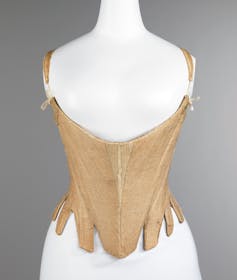
While performing the Tortured Poets Department act of her Eras Tour in Paris in May 2024, Taylor Swift appeared in a custom Vivienne Westwood white dress. It had a fitted bodice and flowing, draped skirts scrawled in lyrics from her single, Fortnight.
While the lyrics have gained the attention of Swifties across the internet, as an expert in Georgian fashion, I was captured by the fitted bodice – a design that was known in the 18th century as stays. It’s a testament to the staying power of 18th-century trends that stays continue to be at the centre of fashion.
Since the Bridgerton effect first took hold in late 2020, fitted corset-like tops have remained in vogue. These corset tops are not inspired by the hourglass cut of 19th-century corsets, but instead the structural underwear of the 18th century.
They have been seen in runway shows and campaigns, including Anne Hathaway for Versace, worn by celebrities such as Emily Blunt, sold by high-street brands and recreated by historic clothing enthusiasts and independent makers on Etsy and Ebay.
“Stays” was the 18th-century term for corset. They were made using up to five layers of fabric including buckram and linen and were covered in wool or silk. They were structured with baleen, more commonly known as whalebone: the bendy and absorbent keratin plates from the upper palette of a whale’s mouth. Pliable like your fingernail, whalebone absorbed moisture and moulded to the body.
Like a supportive hug, stays provided fantastic bust and lower back support, while gently and comfortably shaping a woman’s torso into the conical shape that defined the 18th-century silhouette.

The visual illusion of a smaller waist was not created by tight lacing, but rather, by adding volume to the hips with hoops or panniers (side hoops). No broken ribs or smushed organs – just great posture and Wonder Bra-level cleavage.
Practically, the bust and back support helped women doing manual labour, women of genteel upbringings doing domestic tasks and those at the top of society, where standing at court events for hours was required. Functionally, gowns were not buttoned, laced or zipped (there were no zips till the 19th century), but were pinned in place. Straight pins attached the fabric of the gown to the stays, protecting the body.
Stays were worn by all women in Georgian society, not just the elite. Wealthier women bought stays that were made bespoke by staymakers. They were also available secondhand, and cheaper versions were made with reeds or out of scored leather. Some women even went as far as stealing their stays so that they could achieve the coveted figure.

Women’s morality hinged on wearing stays. The recognisable shape created by the structured undergarment was expressly interlinked with women’s moral and social standing, similar to the 19th-century concept that “cleanliness was close to godliness”. Women without stays were branded as slovenly, mentally unhinged, criminal, or of ill-repute. Wearing a pair of stays meant that a woman could participate in 18th-century society. It was a sartorial signal that she was not destitute, insane, or willing to sell sex for money.
Stays were worn throughout a woman’s life. A lighter version was worn by children from their toddler years, under the impression that an upright figure kept them safe from airborne diseases. And they could be altered and added to as women’s bodies changed, even worn during pregnancy. They were considered a fundamental necessity for 18th-century life.
Modern stays
Stays inspired by the 18th century were first revived in contemporary fashion by Vivienne Westwood in her 1988 Statue of Liberty and 1990 Portrait collections. Westwood, whose attentive and innovative use of historic pattern cutting and making techniques, was at the forefront of the underwear-as-outwear trend.
Historic underwear was reclaimed as subversive, sexy and rebellious. On the heels of the punk aesthetic, wearing historically inspired underwear made of lycra and plastic boning as outwear challenged what types of clothing society thought of as being properly dressed.
Ironically, the garment that defined a woman as morally appropriate within 18th-century society was turned on its head to defy those same definitions in the late 20th century.
The underwear-as-outerwear trend of the 2020s has become widespread, a frequently used motif of the fashion designer that is no longer narrowly associated with more subversive subcultures or fashion niches.
Its continued resurgence today – most recently in spring summer 2024 collections of Westwood, Galliano for Maison Margiela and Gaultier for Simone Rocha, and through pop culture fashion figureheads such as Taylor Swift – suggests it’s not going away any time soon. Could 18th-century inspired corset tops become as ubiquitous as stays once were? Probably not, but their revival would do excellent things for the hunched posture of our screen-obsessed society.
Elisabeth Gernerd does not work for, consult, own shares in or receive funding from any company or organisation that would benefit from this article, and has disclosed no relevant affiliations beyond their academic appointment.
This article was originally published on The Conversation. Read the original article.







